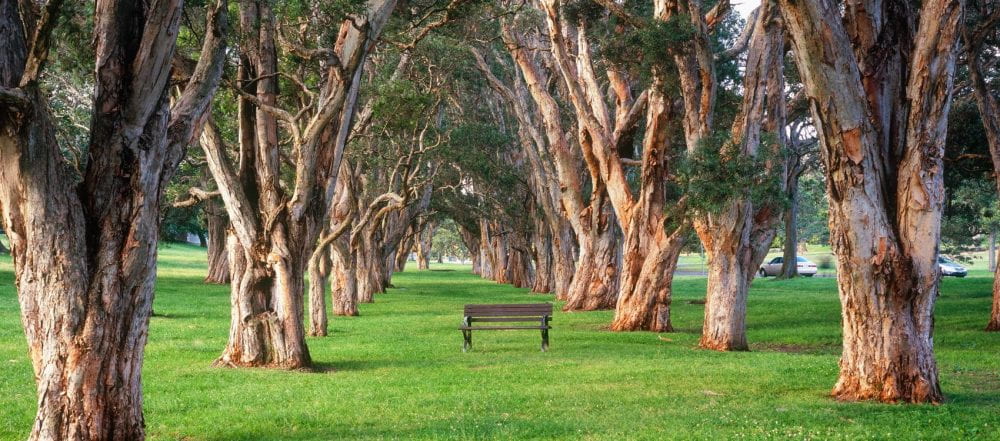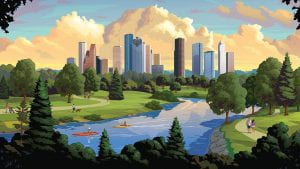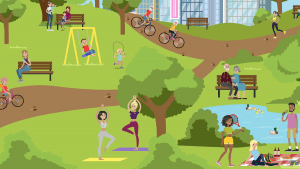The future of greening all depends on the success of incorporating the four just sustainability concepts, which are:
1. Improving our quality of life and well-being
2. Meeting the needs of both present and future generations
3. Justice and equity in recognition, process, procedure, and outcome
4. Living within ecosystem limits
It is important to start thinking about greening in the future because it will affect the well-being of billions of lives. Thinking about green spaces and incorporating greening into cities all over the world will provide our society with a thriving future. The need for more cities to follow and take lead in the greening process is crucial to the future of public health and our environment. The future of green is not just for the benefit of human, health, and society, but for the species and ecosystems that surround us as well.
Wade Reynolds, a Senior Planner at the Hillsborough Metropolitan Planning Organization, emphasizes the ways greening applies to the four just sustainability concepts. Specifically focusing on the concept that addresses justice and equity in recognition, process, procedure, and outcome.
“With regards to equity issues, we do a number of considerations, we are required to comply with title six of the Civil Rights Act, which relates to discrimination based on equity concerns and as well as on race and national origin, language, and as well as environmental justice orders.”
He goes even further to describe how his organization tries to take the next step further and look at requirements by law and as well as other equity aspects that are concerned with access to green spaces.
“We’ve tried to take the next step forward, for example, we look at those areas with Low vehicle ownership, High proportion of transit users, Income, Social Security, Disability recipients, and other factors related in order try and help us look at where all these factors stack up and what places are in the most need of particularly improvements for nonmotorized users of the road.”
The process of Greening and constructing green spaces relate to the other key areas of the just sustainability concepts by:
-
- Directly impacting the quality of life and overall human health and well-being. Both mental and physical health is improved due to the availability and access to green spaces. Green spaces promote outdoor activities, active lifestyles, social interactions, and are proven to relieve stress and other psychological exhaustion.
- Meeting the needs of both present and future generations. The purpose of greening and green spaces is to serve the present and future society, for humans, wildlife, and ecosystems themselves. In regards to climate change impacting both human health and wildlife/conservation health, the push for green spaces provides light to our future generations as they allow urban cities to adjust to the consequences of climate change. Green spaces provide a chance to re-arrange, breathe, and have a cooling effect by reducing the urban heat island effects. Greening reduces air and water pollution, mitigates urban heat effects, and enhances access to nutritious fruits and vegetables. The opportunity to advance the health of both the present and future generations is seen directly with urban greening and allows us to directly address equity and social determinants of health (Jennings, et al., 2). All aspects of life, both present, and future, are in the best interest of green spaces.
- Living within ecosystem limits. Green spaces are designed mainly around the conservation and wildlife within them. Green space location and purpose are directed and chosen based on a number of factors such as wildlife corridors, wildlife habitat, storm mitigation, and flooding, critical species conservation, water resource, and much more. The foundation of constructing a green space is mainly connected to living within the piece of land and its ecosystem limits. The ecosystem provides services within that can be used to benefit itself and human health together, from the streams it provides to the dirt on the ground that can be made into a trail.
The future is in need of a widespread influence of green spaces. Hopefully, our research and informative web case educates the public more on the benefits behind greening and how green spaces make positive impacts on our public health and environmental health. From promoting physical activity and relaxation, to cleaning the air and water and help cool our cities; green spaces do it all. Lack of green spaces harms our human health and well-being and our wildlife and environment, which is why we must influence the need for green spaces in every town and city. We must shift our economy to become more environmentally driven and take different approaches to our urban planning methods. Environmentally-friendly modes of travel, urban farming, and green infrastructures are just some of the many impacting ideas we can build off of from the influence of green spaces. Sydney, Australia, and many more major cities are taking the next step towards a greener future, we just need to get everyone else on board! The future is in our hands, and green spaces are the main push for success.



